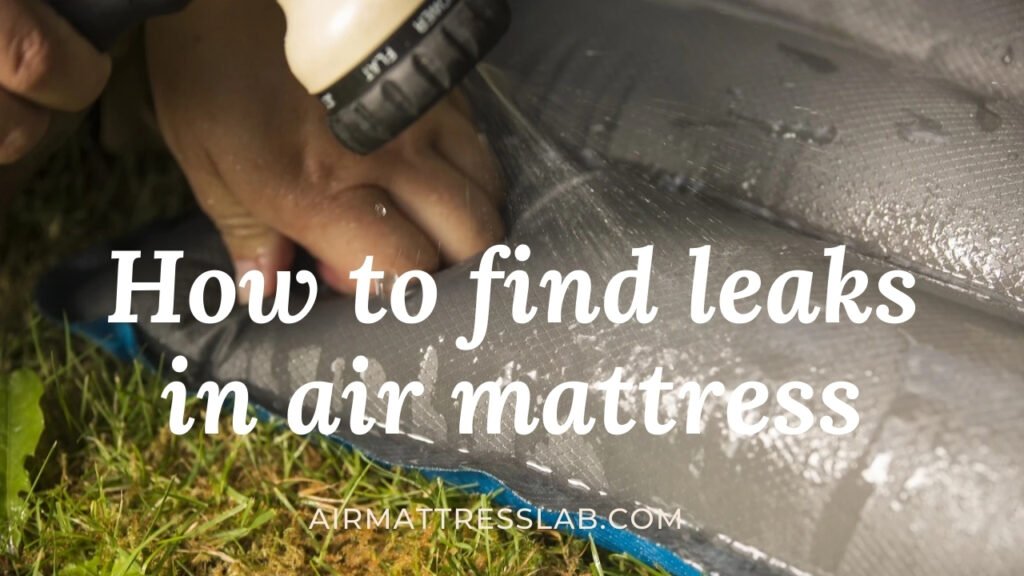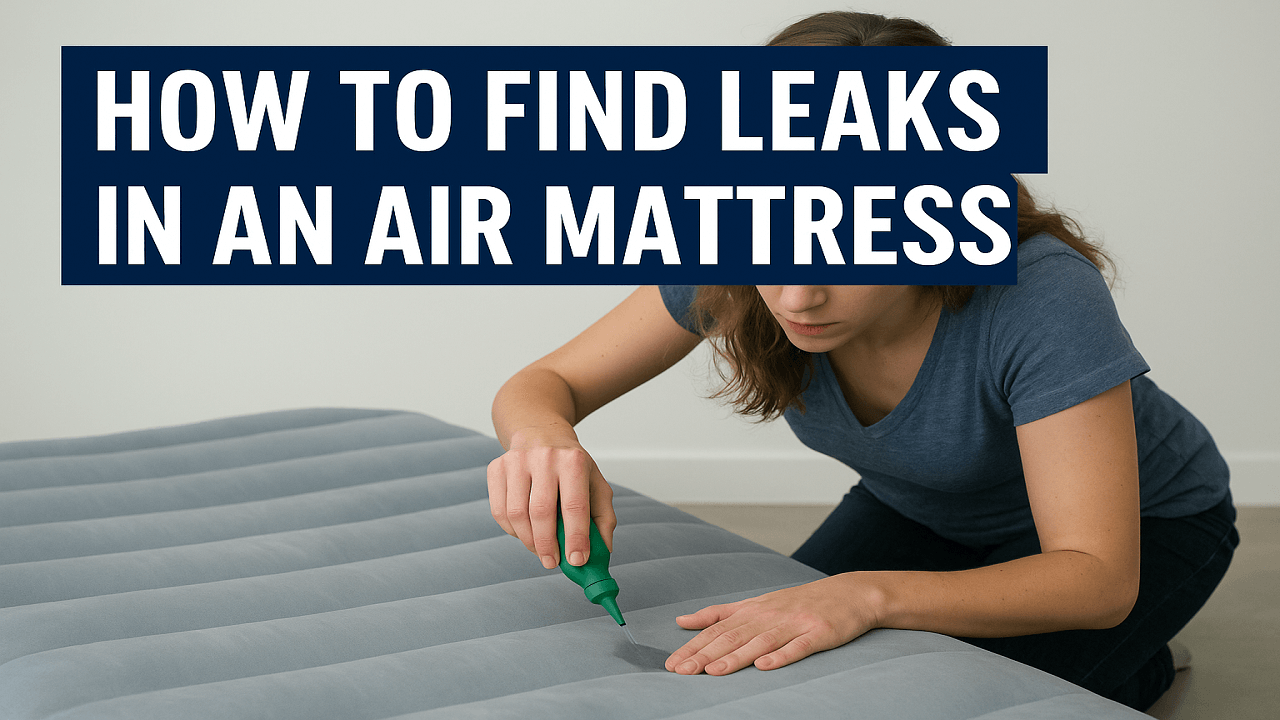Air mattresses are a convenient and portable sleeping solution, whether for camping trips, guest rooms, or temporary bedding. However, one of the most common frustrations for air mattress owners is discovering that their mattress is slowly losing air. Learning how to find a leak in an air mattress can save you time, prevent frustration, and extend the life of your mattress.
Leaks can occur for various reasons, including tiny punctures from sharp objects, valve malfunctions, or material stretching over time. If left undetected, even a small hole can cause your mattress to deflate overnight, leaving you uncomfortable and disrupting your sleep.
This comprehensive guide will show you step-by-step methods to locate leaks, including techniques that don’t require water. We’ll also cover preventative tips to ensure your air mattress remains in top condition. By the end of this guide, you’ll know how to find holes in your air mattress, fix them, and enjoy a durable, reliable sleeping surface.
Table of contents
2. Why Is My Air Mattress Losing Air?
If you’ve ever wondered, “Why does my air mattress keep deflating?” you’re not alone. Understanding the reasons behind air loss can help you locate leaks more easily and prevent future issues.
Slow Leaks vs. Sudden Punctures
Some leaks are gradual, caused by tiny holes or weaknesses in seams. These slow leaks can leave your mattress slightly deflated by morning. On the other hand, sudden punctures from sharp objects, like camping stakes or pet claws, cause rapid air loss. Knowing the type of leak helps determine the best detection method.
Temperature Changes
Air mattresses are sensitive to temperature. Cold nights can cause the air inside to contract, leading to slight deflation. Conversely, warm temperatures expand the air, which can sometimes stress the seams. If your mattress deflates overnight, consider temperature fluctuations as a potential factor.
Overloading and Improper Handling
Exceeding the manufacturer’s weight limit or jumping on the mattress can weaken its material, causing leaks over time. Even dragging the mattress across rough surfaces can damage it. Proper handling is essential for longevity.
Valve Issues
A common source of leaks is the air valve. Even a small gap or improper closure can let air escape. Always inspect valves first when diagnosing why your air mattress is losing air.
By understanding these factors, you’ll be better prepared to find a hole in your air mattress and apply the proper detection method.
3. How to Find a Leak in an Air Mattress: Step-by-Step Methods
Locating a leak in your air mattress doesn’t have to be frustrating. There are several effective methods to find a hole in an air mattress, each suited to different situations. Here’s a detailed breakdown:
3.1 Submersion Method
The submersion method is one of the most straightforward methods for locating a leak.
Steps:
- Partially inflate your air mattress.
- Submerge it in a pool or large container of water.
- Watch for air bubbles escaping from the leak.
Pros: Highly visual, with easy-to-spot bubbles.
Cons: Messy, risk of water inside the mattress, and potential mold growth.
While effective, this method is best for smaller, non-electronic air mattresses.
3.2 Baby Powder Method
This method is helpful if you want a dry way to detect leaks.
Steps:
- Sprinkle baby powder over the mattress surface.
- Inflate the mattress slowly.
- Observe areas where the powder is blown away by escaping air.
Tip: Work in a clean area to minimize mess and ensure the powder highlights the leak effectively.
3.3 Soapy Water Trick
The soapy water method is a favorite among air mattress owners.
You’ll need: warm water, bleach-free dish soap, a sponge or rag, and a bucket.
Steps:
- Mix soap and water in a bucket to create a lather.
- Apply the lather to the inflated mattress using a sponge.
- Watch for bubbles forming—these indicate the location of the leak.
- Mark the leak with a marker for patching later.
Pros: Reliable and precise for small leaks.
3.4 Tissue Paper Method
A great option if you want to find a leak in an air mattress without water.
Steps:
- Fully inflate the mattress.
- Hover a piece of tissue paper near seams, folds, and the valve.
- The tissue will flutter or get pulled toward escaping air.
- Inspect both top and bottom surfaces.
Tip: Best done in a low-breeze environment to detect even minor leaks.
3.5 Manual Inspection
Sometimes, old-fashioned hands-on inspection works best.
Steps:
- Remove bedding and fully inflate the mattress.
- Start with the valve—feel for air escaping.
- Run your hands along seams, folds, and the surface.
- Slowly rotate the mattress to check all areas.
Pros: No materials required, effective for small or hard-to-find leaks.
By using these methods, you can efficiently find holes in your air mattress and prepare for patching or repair.
4. Preventing Future Leaks in Your Air Mattress
Finding a leak is only half the battle. Proper maintenance and preventive measures are essential to keep your air mattress durable and comfortable. Here are actionable tips to ensure your mattress stays leak-free:
4.1 Regular Inspections
Periodically check your mattress for signs of wear and tear, including small punctures, stress on seams, or thinning areas. Detecting issues early allows you to patch them before they worsen.
4.2 Proper Inflation
Avoid over-inflating your mattress. Excess air can stretch the material, creating weak points that are prone to leaks. Follow the manufacturer’s recommended air pressure for optimal performance.
4.3 Use Protective Covers
A protective cover shields your mattress from sharp objects, dirt, and debris. This is especially important in outdoor settings or homes with pets and children.
4.4 Gentle Handling
Lift your mattress instead of dragging it across rough surfaces. Avoid placing heavy objects on it and discourage jumping, which can stretch the material and cause tears.
4.5 Correct Storage
When not in use, deflate the mattress, fold it gently, and store it in a cool, dry place. Avoid areas where it may come into contact with sharp items or extreme temperatures.
4.6 Adhere to Weight Limits
Follow the manufacturer’s recommended weight capacity. Overloading can strain seams and materials, increasing the risk of leaks.
4.7 Timely Repairs
If a small leak is detected, repair it immediately. Addressing minor issues prevents them from becoming larger problems, saving time and prolonging the life of your mattress.
By following these preventive steps, you can reduce the likelihood of leaks and keep your air mattress performing optimally for years to come.
5. Personal Insight on Finding Leaks in Air Mattresses
Having used and maintained numerous air mattresses over the years, I’ve learned that knowing how to find a leak in an air mattress goes beyond simple repair—it’s about proactive care. Small habits can make a huge difference in durability and comfort.
Environment Matters
Where you use your air mattress plays a significant role in its longevity. Outdoors, sharp rocks, sticks, or campsite debris can create unexpected punctures. Indoors, even harmless items like toys or pet claws can cause leaks. Awareness of your surroundings is key.
Handling Is Crucial
How you move and handle your mattress affects its lifespan. Dragging it across floors or over sharp edges subtly wears the material, which can lead to leaks. I’ve found that lifting and carefully positioning the mattress significantly reduces wear and tear.
Routine Checks Are Vital
Regularly inflating and deflating the mattress helps you notice air retention issues early. It also keeps the material flexible, preventing cracks or small holes from forming. I treat these inspections like a “fitness check” for my mattress, ensuring it stays strong and resilient.
Preventive Mindset Saves Time
Instead of waiting for a mattress to deflate overnight, addressing small issues proactively saves frustration. Patching minor leaks promptly and following proper storage, inflation, and handling routines has extended the life of every mattress I’ve owned.
Combining careful handling, routine checks, and preventive maintenance is the most effective way to prevent leaks. With this approach, an air mattress can be a durable, reliable, and comfortable sleeping solution, whether for camping trips, guests, or everyday use.
6. Frequently Asked Questions (FAQ)
1. How can I tell where my air mattress is leaking?
Inflate your air mattress fully and observe its firmness. If it deflates over a few hours or forms depressions, it’s likely leaking. You may hear a faint hissing sound near the leak. Using methods like soap lather, tissue paper, or baby powder can help pinpoint the exact location.
2. How do you find a hole in an air mattress with tissue paper?
Fully inflate the mattress and hover a piece of tissue paper over seams, folds, and the valve. Escaping air will make the tissue flutter, helping you locate the leak. Inspect both top and bottom surfaces for accuracy.
3. Why does my air mattress keep deflating overnight?
Overnight deflation can occur due to slow leaks, temperature changes causing air contraction, new mattress material stretching, or overloading. Always inspect for leaks first and ensure the valve is closed correctly.
4. How do you find a leak in an air mattress without water?
You can use tissue paper, soapy water (applied via sponge, not submersion), baby powder, or manual inspection. These dry methods help locate leaks without the risk of introducing water into the mattress.
5. What should I do if my air mattress is losing air fast?
Check the valve and seams for visible holes. Use any of the detection methods to locate the leak. Patch the area immediately to prevent further air loss. Ensure proper inflation and avoid overloading the mattress in the future to prevent damage.
7. Final Word
Learning how to locate a leak in an air mattress is essential for anyone seeking a reliable and comfortable sleeping surface. By using methods like the submersion test, baby powder, soapy water, tissue paper, or manual inspection, you can efficiently locate leaks and address them before they cause significant deflation.
Preventive care is equally important. Regular inspections, proper inflation, careful handling, and correct storage can significantly reduce the risk of leaks. Following these steps ensures your air mattress remains durable and performs at its best for years to come.
Whether you’re using an air mattress for camping, guest accommodations, or daily use, proactive maintenance and timely repairs save both time and money. By understanding why your air mattress keeps deflating and taking action promptly, you can enjoy a comfortable and dependable sleeping solution without frustration.
Remember, the key to a long-lasting air mattress is combining effective leak detection with thoughtful care and handling. With this approach, your air mattress can remain a practical and enjoyable bedding option, providing you with peace of mind and improved sleep.


